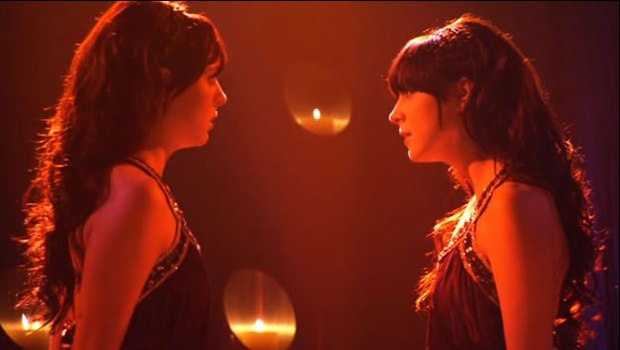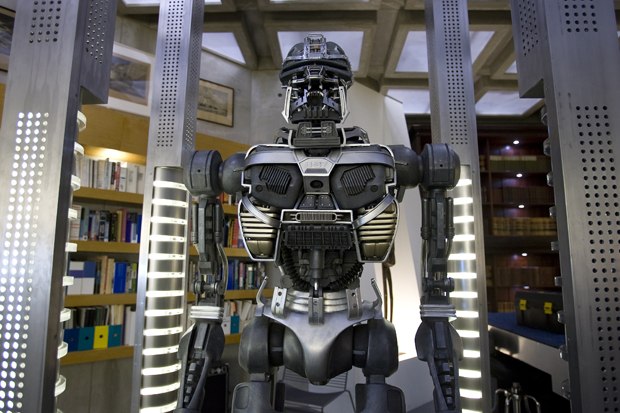Gary Hutzel takes us behind-the-scenes of Caprica.
Check out the Caprica clips at AWNtv!
First the wars: now the social and political events that caused them.
Which is why the genesis of the Cylons is so ripe for exploration in Caprica, the prequel to the highly-acclaimed Battlestar Galactica, premiering tonight on Syfy (9/8c). However, last spring we got a sneak peek when an extended version of the pilot bowed exclusively on DVD from Universal Home Ent. Tonight's series premiere, though, offers more.
But it's very clear that Caprica is no BSG. Despite the great acclaim and terrific production values, there were creative and commercial demands placed on the prequel, so creator Ron Moore made sure that Caprica offered something very different.
"Galactica was unique in that it was a very demanding show for television -- you really had to watch it carefully," explains Gary Hutzel, the visual effects supervisor now overseeing Caprica. "And I think what that meant was that a lot of the stories didn't reach a real wide audience. We had a consistent audience; we had a very dedicated audience. I think the producers felt that it didn't get a wide enough audience: it was great drama; it was a fascinating story. It could've had a wider audience had it not been so relentlessly depressing."
Caprica takes place nearly 60 years before the two robotic Cylon wars and the fall of the 12 colonies, including Caprica. But now there is peace yet the underlying issues that will eventually lead to the annihilation of humankind (a culture of excess, technology, terrorism, racism) begin in this series. One of those big issues is the development of artificial intelligence. The first version of the Cylons created is called the U-87, which actually looks like a more primitive Cylon from the original Battlestar 1978 series. It's created through the investment of wealthy technologist Daniel Graystone (Eric Stolz), who is obsessed with the idea of reincarnating his newly-deceased 14-year-old daughter Zoe (Alessandra Toressani) as a cyborg. The story reveals how, before her death, the young girl, who was also quite brilliant, managed to download "rudimentary elements of her personality and DNA into the machine," forging this astounding hybrid that elicits all sorts of moral and ethical quandaries.
Now that Hutzel is well into the series, he says it's rapidly evolved with heightened use of virtual environments as an interactive escape. "The show is interesting in that it's changed its context quite a bit before we started. In other words, the original premise of Caprica was to explore international relations through the science-fiction framework of a series of planets that represent widely different ethnic groups. As the show moved ahead, there were more and more requests to introduce more of a science-fiction element to that and push it into a slightly more fanciful mode, so we've been accommodating that.
"The show about mid-season completely changed for visual effects because it started off originally with a relatively small effects budget. But as we moved into it, the desire to change the paradigm for the show had us doing more and more effects work. Now, going into the finale, visual effects is running between eight or 10 minutes of screen time in every episode, so we're doing very, very large sequences for virtual reality environments as well as photoreal backdrops.
"For us, it went from being scaled down to: 'All hands on deck; go crazy, we need to do 1,000 shots in the next six months.' To that end, what people will find is that the show is varied -- it is in no way a formula show. The structure of it changes from hour to hour, the tale keeps on shifting: it's complex but the individual shows are self-sustaining."
Indeed, by the fifth episode they will be heavily into virtual environments, which, Hutzel says, entail a film noir touch that's integrated into the show, as he alluded to last year. One of the key backdrops is called New Cap City: "a virtual environment where people go to play a dramatic real life scenario of a rough town, where it's 'kill or be killed'," Hutzel continues. "But in the game, if you are killed, you can't go back. It is similar to life in that once you die, you're dead. So people's motivations become more real in that environment and it's also another way to express human excess so it's a nice dramatic framework and it's very colorful. It uses a lot of iconic imagery from the '30s and '40s to create this environment. It's a fanciful place where the players introduce their own interests. What's interesting is that it brings up these icons and as we move ahead with a new world, which is being created and echoes creation itself.
"Originally, Ron was going to hold off introducing the Cylons. Since then, as the show has come to life and everyone has seen the strong points, he's shifted gears and now we will begin to encompass the rise of the Cylons before the end of the first season. We're moving right into that, which is great for me, because when we first pitched the show more than three years ago and I did artwork, the idea was that the Cylons were already there. Then, it was a matter of figuring out the triggering device that turns them into the enemy. I think when people look back on the first couple of seasons, they're going say this show evolved tremendously.
"All during this, of course, we have a killer robot on the loose -- the U-87 -- so we have these two elements of visual effects storytelling and another difference on Caprica is that we will be able to improve the performances of the robots. Then as we move ahead in the series, we begin to see other colonies on other planets and establish those backdrops and what makes them unique. Right now we're up to about 20 environments. And those environments become part of who these people are. Plus, doing virtual sets for locations that were impossible to get on the schedule that we had also became part of the workflow."
As with the latter part of BSG, Caprica's vfx is done with a small in-house unit. Hutzel admits that it's the best approach creatively and financially. "This is a show that could never be done through a regular facility. The reason is that [a vendor] simply doesn't have the resources to do the storytelling in a profit-making way. For Caprica, we were free to create these environments and present them. By doing that, we were preemptive, for instance, in getting New Cap City into the series with artwork. This would have cost $100,000 with an outside facility. And it helped drive it in a positive direction into the series. Even doing a previs on a sequence would cost $30,000 or $40,000 using an outside vendor. We do it for a small fraction of that in-house and with a team that's uniquely capable."
LightWave 3D continues as the basic workflow. "As we moved into environments, it's a lot more greenscreen work and the environments. We're still on the Battlestar model with three cameras that are freely roving, shooting the scenes spontaneously. My MO on the show is to show up and we work it on the day -- just like a performance.
Bill Desowitz is senior editor of AWN & VFXWorld.











